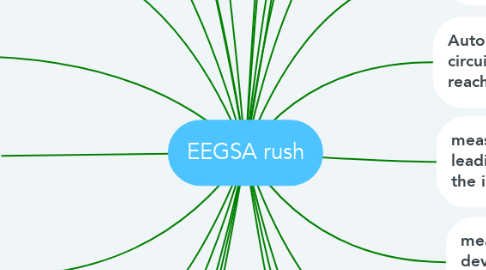EEGSA rush
by Janson Quiej

1. Accessible: capable of being quickly reached from the public highway for repair, replacement or inspection.
2. Channeling: set of ducts or tubes through which the conductors are passed, in order to protect them mechanically and avoid direct contact with them.
3. Installed capacity: It is the sum of the nominal capacity in KVA of all the electrical equipment that will be connected to the connection.
4. Switch rating: this is the maximum current in amps that a switch can constantly withstand without being damaged.
5. ground connection: effective connection by means of a cable that connects the neutral of the EEGSA network and that of the user installation, to a copper grounding rod.
6. EEGSA: acronym for Empresa Eléctrica de Guatemala S.A., whose function is to distribute electricity to users who request it.
7. Installation of a user: includes all the accessories of the electrical network of a building and that conducts the electrical energy inside it. includes the connection installed by the user.
8. Power lines: refers to the conductors that are placed from the feeder network to the corresponding measuring device.
9. meter: device or equipment used to measure electrical energy, which can simply be consumption in KWh, or in addition, KW of power registered in the month and kVARh if it is necessary to obtain the reactive, which relates to the power factor of an installation .
10. Secondary lightning rods: they are devices that protect the equipment against lightning discharges.
11. registered power: it is the maximum value of power registered by a demand meter during a certain period, it is measured in kW.
12. Request for services: it is the request that a future user makes to his legal representative before EEGSA, in order to obtain the supply of electrical energy for a property
13. network variant: it is any modification to the existing EEGSA network.
14. Watt: measure of power, means Watt
15. Connection: set of components used to transport electricity from EEGSA's distribution lines.
16. Ampacity: refers to the conduction capacity of conductors, expressed in amperes.
17. Interrupting Capacity: it is the maximum short circuit current that can be interrupted at nominal voltage in a switch, without damage to its structure.
18. service class: refers to the technical and commercial characteristics of the load to be connected.
19. service contract: it is the agreement entered into between EEGSA and the user, by means of which both parties agree to comply with the clauses necessary for the distributor to provide the electric power service.
20. Hertz (Hz): measures the frequency of an electrical system.
21. Automatic switch: it is a device designed to open a circuit automatically when the current in amperes reaches a certain level.
22. measured lines: refers to the conductors leading from the measuring equipment to the installed load.
23. means of connection and disconnection: devices used to connect or disconnect the load.
24. contracted power: it is the value of power required by the user, according to their need, expressed in kW
25. seals: these are the security devices, which are placed on the meters and at the EEGSA points it deems appropriate, in order to prevent unauthorized persons from having access to the inside of them.
26. user: Individual legal person who receives electricity service from EEGSA through a connection
27. Nominal voltage: is the value assigned to the magnitude of the voltage of a system, in order to classify them, 120/240/480 volts etc.


